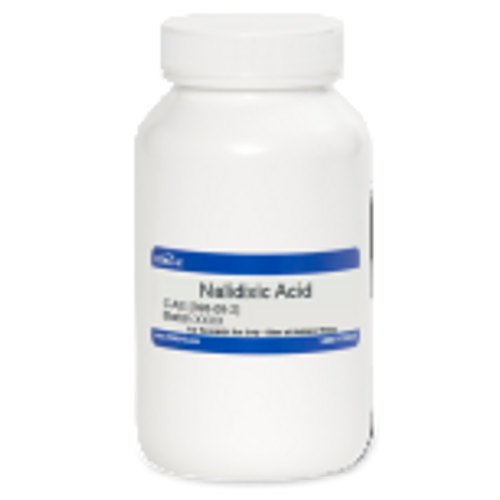Nalidixic Acid is a synthetic 1,8-naphthyridone antibiotic similar in structure and mechanism to quinolones. It can be used as a tool to study bacterial division regulation. The compound can also be used in the RADAR assay, a method for isolating DNA-protein adducts and their identification and quantification. It is bacteriostatic in lower concentrations and bactericial in higher concentrations. The product is commonly used as a selective agent in many isolation media. Nalidixic Acid is freely soluble in methanol and methylene chloride and slightly soluble in aqueous solutions.
We also offer:
- Nalidixic Acid Sodium, CulturePure® (N001)
| Mechanism of Action | Nalidixic Acid indirectly inhibits proteins synthesis by binding DNA and interfering with enzymes involved in DNA replication and transcription. It inhibits the A subunit of DNA gyrase and topoisomerase IV and induces formation of cleavage complexes. It also inhibits the nicking-closing activity on the subunit of DNA gyrase that releases the positive binding stress on the supercoiled DNA. |
| Spectrum | Nalidixic Acid is a broad-spectrum antibiotic commonly used against bacteria responsible for urinary tract infections. It is primarily used for Gram-negative bacteria. |
| Microbiology Applications | Nalidixic Acid is commonly used in clinical in vitro microbiological antimicrobial susceptibility tests (panels, discs, and MIC strips) against Gram-positive and Gram-negative microbial isolates. Medical microbiologists use AST results to recommend antibiotic treatment options. Representative MIC values include:
Media SupplementsNalidixic Acid can be used as a selective agent in several types of isolation media: Columbia Blood Agar - Staphylococcus/Streptococcus selective supplement Wilkins-Chalgren Anaerobe Agar - Isolation of non-sporing anaerobes Wilkins-Chalgren Anaerobe Agar - Isolation of Gram-negative anaerobes Columbia Blood Agar - Gardnerella vaginalis Selective Supplement Listeria Enrichment Broth - Listeria Selective Enrichment Supplement Listeria Enrichment Broth - Listeria Selective Enrichment Supplements UVM I and UVM II Listeria Enrichment Broth - Modified Listeria Selective Enrichemnt Supplement Fraser Broth - Fraser Supplement Fraser Broth - Half Fraser Supplement Brucella Medium Base - Modified Brucella Selective Supplement Buffered Listeria Enrichment Broth - Listeria Selective Enrichment Supplement Chromogenic Listeria Agar - Chromogenic Listeria Selective Supplement Chromogenic Listeria Agar - Chromogenic Listeria Differential Supplement |
| Cancer Applications | A novel ionic Ag(I)−piperazinium nalidixic acid conjugate was synthesized as a potential antitumor agent. The cytotoxicity activity was done via a SRB assay on MIA-PA-CA-2, HepG2, HeLa and MCF7 human cancer cell lines. The conjugate showed a specific and selective antitumor activity for the MIA-PA-CA-2 cancer cell line with a GI50 value <10 (Yousuf et al, 2018). |
| Molecular Formula | C12H12N2O3 |
| Impurity Profile | Residue on Ignition: ≤0.2% Heavy Metals: ≤0.002% |
| References |
Kiianitsa and Maizels used Nalidixic Acid (TOKU-E) to study DNA gyrase inhibition in E. coli K-12 in: "Ultrasensitive isolation, identification and quantification of DNA–protein adducts by ELISA-based RADAR assay" Levitt M et al (1973) Studies on the mechanism of action of Nalidixic Acid. Studies on the mechanism of action of Nalidixic Acid 4.4:479-486 Yousuf I, Usman M, Ahmad M, Tabassum S ad Arjmand F (2018) Single X-ray crystal structure, DFT studies and topoisomerase I inhibition activity of a tailored ionic Ag (I) Nalidixic Acid-piperazinium drug entity specific for pancreatic cancer cells. New J. Chem 42:506-519 |
| MIC | Aeromonas spp.| ≥32|| Bacillus subtilis| ≥3.13|| Bacteroides fragilis| 2 - 64|| Bifidobacterium adolescentis| 62.5 - 125|| Bifidobacterium animalis| ≥500|| Bifidobacterium bifidum| 31.25 - 62.5|| Bifidobacterium breve| >500|| Bifidobacterium Infantis| ≥125|| Bifidobacterium longum| 62.5 - 125|| Bifidobacterium pseudolongum| 62.5 - 125|| Bifidobacterium sp.| 125 - 250|| Bifidobacterium thermophilum| ≥125|| Borrelia burgdorferi S.L.| 128 - >512|| Brucella suis (ATCC 27531)| ≥125|| Campylobacter jejuni| 2 - >256|| Campylobacter spp.| ≤1 - ≥64|| Citrobacter freundii| 4 - >32|| Citrobacter koseri| 2 - >32|| Clostridium perfringens| ≥8|| Clostridium spiroforme| ≥8|| Enterobacter aerogenes| 2 - >32|| Enterobacter cloacae| 2 - 512|| Enterobacteriaceae| 1 - 128|| Enterococcus faecalis| >32|| Enterococcus faecium| ≥32|| Escherichia coli| 1 - 256|| Haemophilus influenzae| 0.71 - 2|| Haemophilus spp.| 0.015 - 2|| Klebsiella pneumonia| 2 - >64|| Lactobacillus acidophilus| 250 - >500|| Lactobacillus bulgaricus| ≥500|| Lactobacillus casei| ≥500|| Lactobacillus lactis | ≥500|| Lactobacillus paracasei| ≥500|| Lactobacillus plantarum| ≥500|| Lactobacillus rhamnosus| ≥500|| Lactobacillus spp.| ≥500 ->1024|| Legionella pneumophila| 2|| Moraxella catarrhalis| 2 - 4|| Morganella morganii| 1 - >32|| Mycobacterium smegmatis| 3.125 - 50|| Neisseria spp.| 0.5 - 8|| Plesiomonas shigelloides| ≥32|| Proteus mirabilis| 4 - >32|| Proteus morganii | 1.56|| Proteus rettgeri | 1.56|| Proteus spp.| 4 - 4.1|| Proteus vulgaris| 1.56 - 4|| Providencia rettgeri| 4 - >32|| Providencia stuartii| 2 - >32|| Pseudomonas aeruginosa| <1 - >128|| Pseudomonas spp.| 32 - 128|| Salmonella enterica| 1 - >32|| Salmonella Enteritidis| 3.13|| Salmonella Paratyphi| 0.78|| Salmonella schottmulleri| 0.78|| Salmonella typhi| 4 - >184000|| Serratia marcescens| 1 - >32|| Shigella| 1 - 64|| Shigella flexneri| 0.12 - <4|| Shigella sonnei| 0.12 - 32|| Shigella spp.| 1.15 - 8|| Staphylococci| 16 - 128|| Staphylococcus aureus| >8 - >128|| Stenotrophomonas maltophilia| 8 - 32|| Streptococcus agalactiae| >32|| Streptococcus pneumonia| >128|| Streptococcus pyogenes| >32 - >100|| Treponema hyodysenteriae | ≥100|| Xylella fastidiosa| 16 - 32|| Yersinia enterocolitica| 4 - 8|| |








